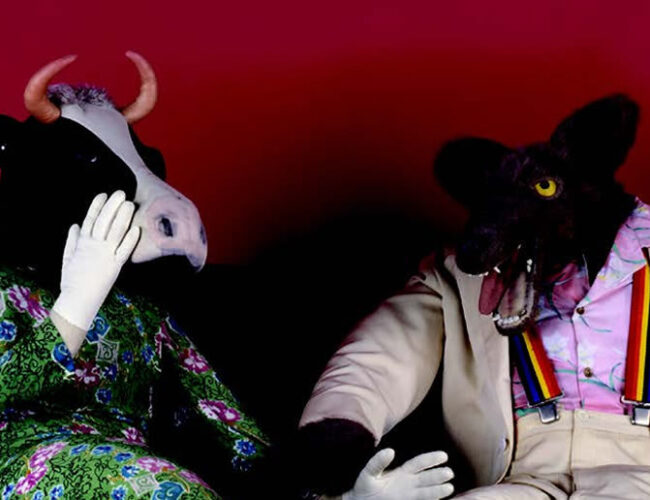Lloyd’s Treasure Chest
Folk Art in Focus
 Ray, the Wolf, and Agnes Vacca (lovingly known as Elsie), Mary Bowman, mid-twentieth century, New York, New York. Various fabrics. Gift of Lloyd E. Cotsen and the Neutrogena Corporation. Museum of International Folk Art
Ray, the Wolf, and Agnes Vacca (lovingly known as Elsie), Mary Bowman, mid-twentieth century, New York, New York. Various fabrics. Gift of Lloyd E. Cotsen and the Neutrogena Corporation. Museum of International Folk Art
BY FELICIA KATZ-HARRIS
After a four-year hiatus, our special open-storage gallery, Lloyd’s Treasure Chest, is reopening with a fresh face. Visitors can take the Vehicle to the Vault (formerly known as the elevator) to the new Treasure Chest, a place for visitors to explore, interact, and create folk art.
True to donor and former Neutrogena Corporation CEO Lloyd Cotsen’s original vision, the gallery is set up to be open-storage, allowing visitors access to collections treasures not on exhibit. Visitors will be able to see inside the Neutrogena Collections Vault, and may witness behind-the-scenes activity if staff members are working in the room. Some museum favorites will be featured in the view to the vault, like Ray and Elsie, (see photo at top of facing page) and a wedding rickshaw from Bangladesh. Other areas of the gallery will offer visitors ideas of how museum curators and collaborators think about folk art as they collect its treasures, posing questions such as, “What is folk art?”
We at the Museum of International Folk Art ask ourselves this question almost daily. Rest assured, there is no one definition of folk art, and even within the museum, we vary in our opinions and ideas. Nevertheless, by collecting folk art, the Museum of International Folk Art essentially defines what it thinks folk art is. Most generally, today, the museum thinks of folk art as traditional art. However, recognizing that contemporary, living, traditional art is not static, the museum’s notion of folk art very much includes innovations in traditions.
Unexpected examples from the folk art collection are on display: a machine-printed, machine-sewn fashion ensemble from Zambia; mechanized toy robots from Japan; and The Last of the Red Hot Lovers, (see photo on opposite page) a biggerthan-life muffler man. You’ll also see some of the usual suspects, like a papier-mâché calavera (skeleton) figure from Mexico in mariachi costume.
MOIFA curators, educators, collections managers, artists, and research associates share honest responses regarding whether or not they think these objects are folk art, and there are opportunities for visitors to share their opinions, too.
In the spirit of open-storage galleries, with a view into the vault, the gallery additionally features changing, thematic displays—highlights from the museum’s collection of treasures. The first display, The Basket Case, showcases baskets from around the world, as well as items constructed with basketry techniques: furniture, hats, and dolls. Interactive software encourages visitors to explore items on view to learn more about them, as well as to explore the museum’s collections that are not on view.
But nothing helps you understand what folk art is better than making some yourself. Hands-on, help-yourself art-making activities in the gallery are geared toward all ages. Whether your goal is to learn more about folk art, find your favorite object, or make your own (or all three), you’ll find what you’re looking for in the Treasure Chest.
Felicia Katz-Harris is the senior curator of Asian, Middle Eastern, and Oceanic folk art at the Museum of International Folk Art and curator of the renovated Lloyd’s Treasure Chest: Folk Art in Focus. Her past exhibitions include Tako Kichi: Kite Crazy in Japan and the award-winning Dancing Shadows, Epic Tales: Wayang Kulit of Indonesia
